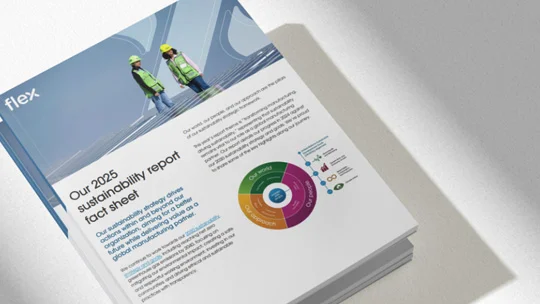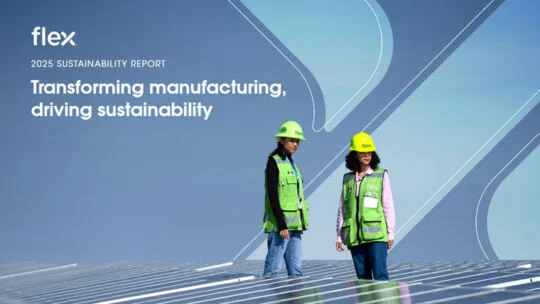
收集可持续发展数据供内部使用——无论是为了建立当前活动的基线、设定未来目标,还是衡量进展——都是一项宝贵的工作。但制定强有力的信息披露方法,以易于理解的形式验证这些信息并与利益相关者共享,才是将可持续发展项目提升到更高水平的关键。

在分享可持续发展数据方面,人们可能会感到担忧,这可以理解,尤其是对于尚未达成目标的组织而言。然而,持续的报告不仅体现了对承诺的履行,也体现了与关键利益相关者建立信任的决心。
此外,随着可持续性成为消费者、员工和投资者更加重视的事项,公司将需要一个可靠的报告框架来满足新的监管要求和公众对企业透明度日益增长的需求。
选择报告框架
选择至少一个符合利益相关者需求的报告框架至关重要。目前,全球许多公司依赖两套成熟的标准来衡量和报告可持续发展指标。全球报告倡议组织(GRI)和可持续发展会计准则委员会(SASB)都为可持续发展报告提供了全面的框架和指导。
使用 GRI 和/或 SASB 作为报告框架,可确保跨组织和行业的方法一致性。这也确保关键绩效指标 (KPI) 与广泛用于衡量可持续发展举措影响的指标相匹配。
尽管两套标准之间存在着无数细微的差异,但在 GRI 和 SASB 之间做出选择的公司应该牢记最初的问题:利益相关者是谁?
GRI 适用于主要关注向客户和员工披露信息的私营公司。GRI 是一个国际组织,在可持续发展报告领域拥有超过二十年的经验。GRI 标准涵盖范围更广,将有助于构建广泛认可、一致的可持续发展指标的坚实基础。
对于上市公司而言,SASB 标准涵盖了更广泛的利益相关者。与 GRI 框架不同,SASB 关注的是投资者和股东关注的财务实质性问题。这些指标有助于了解公司如何通过降低风险和负责任的资源管理来长期运营。
2009年,我们开始披露可持续发展数据时,整合了这些国际框架的一些要素。但到了2013年,我们开始将报告与GRI框架进行整合。即便如此,我们早期的数据收集方法仍是手动将数据输入电子表格,而这一流程后来发展成为一套更加稳健、完善的内部系统。
随着组织在可持续发展道路上日趋成熟,他们可能会开始使用 GRI 和 SASB 来制定披露框架,并与主要利益相关者分享重大问题和影响。
随着可持续发展报告标准和管理机构的变化,Flex 也将不断改进我们的方法。例如,近年来,投资者越来越关注气候相关财务披露工作组气候融资工具 (TCFD) 就企业应披露的信息提供建议,以支持气候相关风险的评估和定价。我们通过年度 CDP 气候变化和水资源安全披露,披露了部分 TCFD 框架,并致力于将完整的框架纳入我们的报告活动中。
参考您的重要性评估
正如在上一篇进行实质性评估对于识别和优先考虑可持续发展重点领域至关重要。这项重要工作还能确定哪些可持续发展指标对组织至关重要。GRI 和 SASB 均内置了实质性评估工具,可供参考。
重要性评估还使组织能够评估和确认利益相关者认为最有益的数据点。
我们用于报告的一些示例问题包括:
- 如何向投资者保证我们的组织能够很好地应对未来的气候风险?
- 在包容性努力、安全和其他员工关注的问题方面,我们如何才能在保护员工隐私的同时保持透明?
- 顾客想知道他们的消费习惯对环境和社会产生哪些影响?
这些问题的答案将有助于塑造和聚焦可持续发展报告,并制定标准化的关键绩效指标 (KPI)。在我们的年度可持续发展报告,我们根据与 GRI 和 SASB 一致的特定 KPI 进行披露。
做好可持续发展报告也需要时间和资源投入。鉴于不断变化的需求以及对可持续发展绩效和指标日益增长的关注,第三方数据验证的需求将持续增长。聘请组织外部的公正专家审查可持续发展数据至关重要,以确保数据收集流程的合理性和数据的准确性。这不仅能为报告工作增添可信度,还能增强人们对未来方法的信心。
关于不利结果的警告
过去十年,可持续发展报告的概念发生了重大转变。可持续发展报告不再仅仅是组织分享其环境和社区活动积极故事的平台。讲述令人愉悦的故事并非衡量可持续发展绩效的真正标准。
毋庸置疑,有时公司可能没有最有利的可持续发展数据可供披露。例如,他们的某个工厂的用水量可能超出预期,或者他们可能尚未在劳工实践目标方面取得重大进展。
这是否意味着组织可以选择不报告数据?
答案是否定的:一旦建立了框架并承诺根据特定的 KPI 进行报告,组织就必须优先考虑透明度,并且不要回避讲述完整的故事,即使没有达到某些目标。
企业应该在此披露行动计划。可持续发展报告使企业能够评估绩效,发现需要改进的领域,并采取果断行动解决现有问题。没有衡量,就没有进步。如果企业尚未达到预期目标,收集和披露可持续发展数据将有助于为未来目标设定基准并制定计划。
制定明确的行动计划,能够确保组织在稳步推进的同时,履行责任,即使目标远大。建立信任、有效沟通可持续发展数据,并展示实现目标的计划,能够让利益相关者理解,当前的披露是可持续发展进程的一部分,而非最终目标。
可持续性信息披露的未来
可持续发展报告不断发展,但并非昙花一现。同样重要的是,要牢记欧盟可持续活动分类法、《可持续财务披露条例》(SFDR)以及联合国《工商企业与人权指导原则》。此外,《企业可持续发展报告指令》(CSRD)旨在加强和扩大整个欧盟的可持续发展报告要求,要求更广泛的公司披露更深入、更实质性的财务信息。
人们对提高可持续发展数据和举措透明度的需求显著上升。随着时间的推移,全球范围内的可持续发展信息披露将变得更加普遍和标准化,这将使投资者、客户和员工更容易衡量组织与其他组织的表现。
除了GRI和SASB之外,投资者现在也使用可持续性评级机构(包括机构股东服务ESG(ISS ESG)、摩根士丹利资本国际(MSCI)和标准普尔全球(S&P Global))来评估其基金和投资组合中的公司。投资者和客户还会考虑CDP关于气候、水和供应链的指南。全球各地的组织都被要求以更严格和更频繁的方式报告其可持续性数据,我们已经看到一些公司将这些信息整合到提交给股东的年度报告中。
组织在制定披露框架时应深思熟虑、全面周到,并采取循序渐进、分阶段的方式。一个常见的错误是,以为启动会很快,而实际情况是,要达到有信心发布可持续发展报告并根据公认的框架进行全面披露的程度,通常需要三到五年的时间。
披露可持续性数据可能并不总是一个舒适或简单的过程,但对于希望在利益相关者致力于建设可持续未来的世界中取得成功的组织来说,这是一项至关重要的实践。





